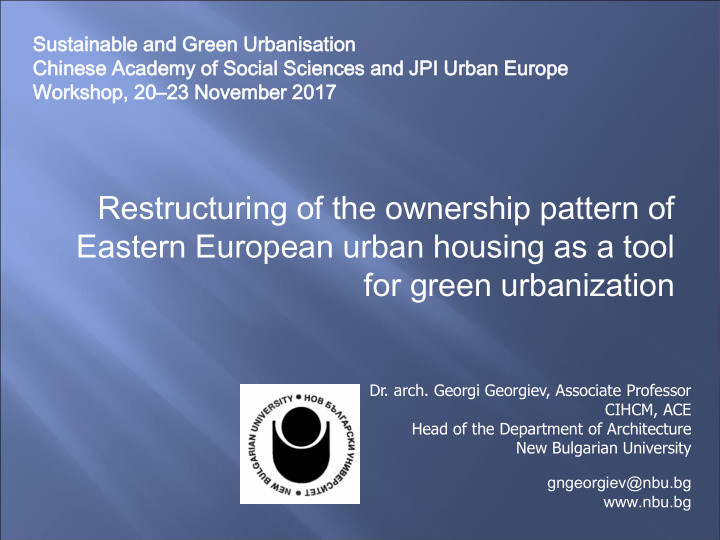



Sust stainab ainable le and d Green een Urban banisa isation ion Chine nese se Acade demy my of So Socia cial Scien ences ces and d JPI Urban ban Euro rope pe Wor orksho kshop, p, 20 – 23 3 Novembe vember r 2017 17 Restructuring of the ownership pattern of Eastern European urban housing as a tool for green urbanization Dr. arch. Georgi Georgiev, Associate Professor CIHCM, ACE Head of the Department of Architecture New Bulgarian University gngeorgiev@nbu.bg www.nbu.bg
New Bulgarian University – member of European Federation for Living http://www.ef-l.eu/our-members/universities
Housing development (in spatial, social and economic terms) is of vital importance for sustainable and green cities. Common problems of the housing estates in Eastern European biggest cities: • high density high rise apartment buildings developed in 60-90 of XX century • low housing standard and high energy consumption in multi-storey housing • deteriorated status of condominium housing due to lack of proper maintenance
East European countries have the legacy of an excessively controlled ‘command’ housing system, which operated till the early1990s . Home ownership, particularly in urban areas, was discouraged; all housing was universally affordable due to extensive subsidies and macroeconomic regulation of prices. There were differences among national systems, including reliance on ‘encapsulated market solutions’ (Yugoslavia, Bulgaria, Hungary)
Th The urban an develo lopm pmen ent t in Ea Easter ern Eu Europea ean n big citie ies s in the period od 1960-199 1990s 0s:
Th The urban an develo lopm pmen ent t in Ea Easter ern Eu Europea ean n big citie ies s in the period od 1960-199 1990s 0s:
Forced industrialisation in most countries from the region Intensive urbanization - migration of population from rural areas to the big cities Shortage of housing in big cities imposed fast expansion of new high rise housing estates developed by industrial technologies
poor quality “large panel“ technology as most used method of new housing construction in 60-80-ies of XX century
Th The housi sing ng in befor ore 1990s: s: Layouts from a housing module (designed in 1960- ies
In most of Eastern European countries: rental stock massively privatized (beyond the reasonable level) • after political changes in late 80-ies of XX century together with imposing obligations for collective management and payment of running costs Homeowners’ associations established according to privatization • contracts In some EE countries including Bulgaria : condominium property established mostly BEFORE the political • changes government used to transfer the property of the apartments to • their future residents without creating rules for proper building maintenance
New condominium laws have been approved after 1990 in Romania, Bulgaria, Poland etc. Such legislation was targeted mostly at regulation of use of newly privatised public housing stock. The condominium legislation however in many countries fails to impose in reality an obligation on residents to take responsibility for buildings, which in practice leads to further deterioration of the stock
In some EE countries including Bulgaria problems are more complicated due to: • extremely high share of the homeownership • lack of and experience and legislation concerning the maintenance and management of condominium buildings As a result: • more than 50% of the owner occupiers do not have sufficient income to cover the current costs of the services • contradiction between the status of an apartment owner and the income level of the residents • increasing decapitalization of the condominium buildings
Differences in housing situation across Eastern European centres of urbanization but existing common need of adequate maintenance and management policy in large high rise scale apartment housing Bulgarian Housing Association
What should be done in EE countries in order to improve the high rise housing structures and therefore to facilitate green urbanization? part of existing condominium housing that was • privatized massively after the political changes in 90- ies of XX century has to be converted back in rental housing prior to regeneration. the retrofit of remaining condominium housing needs • to be flexible, bottom up oriented, homeowners friendly and managed by decentralized structures Housing retrofit costs are to be covered by savings of • energy savings afterwards
Housing Associations – a main engine for implementation of large scale housing regeneratioin activities as a part of green urbanization: establishment of Housing Associations as non-profit a. companies set up according to a specific legislation taking over the municipalities’ duty to develop, b. manage and maintain social housing units housing associations acquire, retrofit and manage part c. of the existing condominium housing stock through purchasing at market price from the condominium tenants
Newly established housing associations will facilitate the start of the large scale energy efficient renovation activities for existing multistorey housing structures. As it happens in Western Europe, housing associations can take over on behalf of the municipality the coordination role between different stakeholders of the housing renovation and urban regeneration process as a whole.
Thank you! Dr. arch. Georgi Georgiev, Associate Professor CIHCM, ACE Head of the Department of Architecture New Bulgarian University E-mail: gngeorgiev@nbu.bg www.nbu.bg
Recommend
More recommend